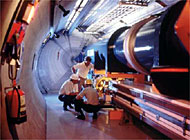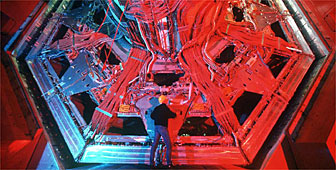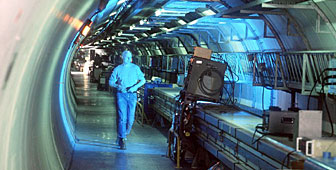Hole in the ground to probe secrets of the universe

Europe's top particle physics laboratory, Cern, has moved a step closer to building the world's largest scientific instrument to investigate the mysteries of the universe.
On Wednesday, the Swiss president, Pascal Couchepin, inaugurated a huge underground cavern near Geneva, which will house an experiment called Atlas.
Standing as high as a six-storey building and twice as long, Atlas will almost fill the purpose-built cavern which has been excavated over the past two years.
The particle detector should help physicists understand what matter is made of and what forces hold it together and, ultimately, why our universe is the way it is.
Milestone
Atlas is one of several experiments in preparation for Cern’s new particle accelerator, the Large Hadron Collider (LHC), which is due to start up in 2007.
The LHC aims to recreate the conditions that are believed to have existed immediately after the “Big Bang” explosion – about 15 billion years ago – that created the known universe.
Scientists say this will give a much clearer view of how this created galaxies, planets – and the life that so far is only known to exist on Earth.
The LHC will operate in a 27-kilometre circular tunnel 75 metres deep, between Lake Geneva and the Jura mountains.
Vital clue
One of its main goals will be to catch a glimpse of a sub-atomic particle known as “Higgs boson” that has eluded scientists at Cern and its US counterpart, Fermilab, for nearly two decades.
It is believed that “Higgs boson” could provide vital clues about matter and weight.
The LHC replaces an earlier decade-long experiment known as the LEP, now dismantled, which two years ago came tantalisingly close to catching a glimpse of the particle.
Like the LEP, but many times more powerful, the LHC will project particles of matter at vast speeds in opposite directions around the tunnel, and the 7,000 tonne Atlas and another detector will record what happens when they collide.
Some 2,000 scientists from 150 research laboratories in 34 countries are involved in the $8 billion (SFr10.6 billion) LHC project.
Cern, founded 50 years ago, is mainly funded by its 20 European member states, but the European Commission, India, Israel, Japan, Russia, the United States and Turkey have observer status and contribute to the body.
swissinfo with agencies
Cern, the European Organisation for Nuclear Research, was founded in 1954.
There are currently 20 member states.
The laboratory sits astride the Franco-Swiss border west of Geneva.
Some 7,000 scientists, half of the world’s particle physicists, use Cern’s facilities.
They represent 500 universities and over 80 nationalities.

In compliance with the JTI standards
More: SWI swissinfo.ch certified by the Journalism Trust Initiative



You can find an overview of ongoing debates with our journalists here. Please join us!
If you want to start a conversation about a topic raised in this article or want to report factual errors, email us at english@swissinfo.ch.